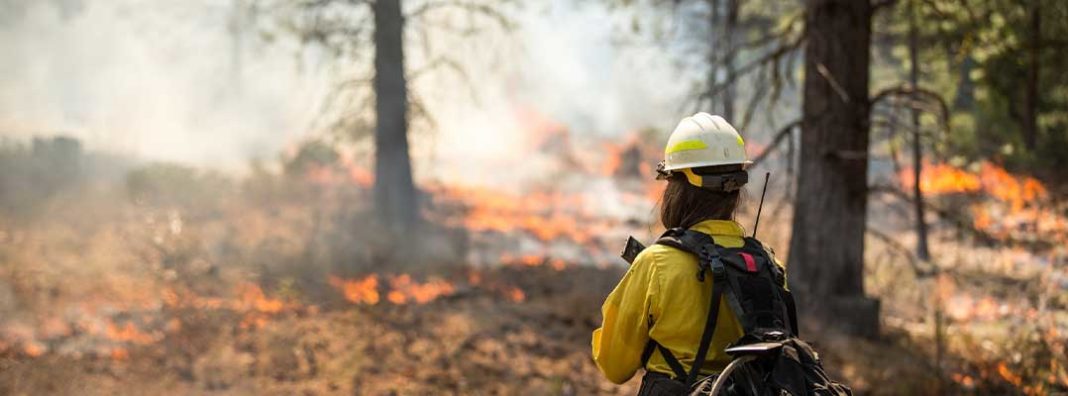
This piece is the third of a multi-part series by Brian Isom on wildfires. Click to read parts one, two, and four.
Earlier this month, the Chief of the US Forest Service, Vicki Christiansen, cautioned that there are currently 1 billion acres of land in the US at risk for catastrophic wildfires. To give that number some perspective, the lower 48 states have a total land mass of 1.9 billion acres. Now imagine over half of that on fire. This is the reality we are dealing with currently in this country.
How did we get here? The short explanation is that as Europeans began to settle in the west, they started to eliminate fire from landscapes that were well adapted to fires. This led to a densifying of western forests, a buildup of dead and dying underbrush, and the spread of plant-based disease and infestations. All of that has not only led to unhealthy forests but has created what forest experts refer to as a fire-debt. And now, it seems, mother nature is looking to cash in.
Today, many are referring to the recent prevalence of large, destructive wildfires as the new normal. News outlets report that fires keep getting bigger and there is no end in sight. A glance at the current data available from the National Interagency Fire Center seems to confirm that belief. Since 1985, the number of fires burning in the US has remained fairly constant, while the number of acres burning each year is trending upward (orange bars in figure 1). Naturally, so is the money federal agencies are spending on suppressing those fires, albeit at a much more accelerated rate (red line in figure 1). Last year’s spending topped $3 billion for the first time ever, up from just $500 million in 1985.
Data from the National Interagency Fire Center. In 30 years, annual spending on suppression has jumped from $500 million to over $3 billion.
Zoom further out, however, and you will soon realize that this trend is not the new normal, but is a return to tradition. Several scholars have noted that before Europeans began to settle in the west, fires were burning on a much, much larger scale. One study of historical burn data cites fire occurrences upwards of 10 times what western states have experienced in recent years. Considering this data, it is imperative to change the approach we take to fight wildfires. Current efforts focus heavily on reactive measures: once a fire begins to spread, crews respond quickly in an attempt to contain it. The best way we have to adapt to changing fire trends, however, is to become more proactive in the way we manage forest fires. That means a heavier reliance on preventative measures like prescribed burns and re-working regulation to give fire managers more flexibility to take necessary steps to prepare for wildfire season.
Putting out a wildfire is much different than putting out a campfire or even a house fire. The size, speed, and heat with which wildfires burn are so intense that water — even when dropped from helicopters and airplanes by the hundreds of gallons — is ineffective as a means of stopping wildfires. As Scott McLean, spokesman for the California Department of Fire and Forestry Protection stated so simply:
“We don’t just put blue stuff on the red stuff.”
In fact, there is a whole lot more taking place on the ground to prevent the spread of fire. The only real way to stop a wildfire is to let it burn itself out, which means starving it of combustible fuels. Crews armed with chainsaws, axes, and when possible, bulldozers, work to create breaks in the vegetation — known as fire and fuel breaks — that serve as barriers to the spread of fire. Water and fire retardant dropped from planes only slow the burns so that crews have more time to respond on the ground.
Suppressing wildfires, however, is costly — on average, $2.3 billion dollars each year for the past 5 years. It is also not always effective at containing and extinguishing fires. Extreme weather conditions, high wind, or shifting fires can jump fire breaks. They can also move so fast that fire crews can’t respond in time to save towns from burning, which is exactly what led to the loss of Paradise, California last year.
Faulty transmission lines sparked the blaze in a wooded area 7 miles from the secluded town of Paradise, home to around 26,000 people, in November of 2018. It took the fire no more than 90 minutes to reach the town of Paradise. At the height of the blaze, it was moving so quickly that it consumed the equivalent of 60 football fields every minute. Paradise was, sadly, doomed the moment that fire began.
Prescribed fires, often referred to as controlled burns, offer an alternative to large wildfires while still providing historically fire-adapted ecosystems the benefits of a burn. Where wildfires are spontaneous and unpredictable, prescribed fires are well-planned and executed. They only take place when weather conditions are right and in areas fire crews have already prepared. Because conditions are optimal and the behavior of the fire is predictable, proactive management through controlled burns is much less expensive than reactive suppression efforts. According to John Twitchell, a forester with the Colorado State Forest Service:
“Every dollar you spend (on mitigation), you’re saving four on suppression costs.”
And the problem is only getting worse. As more and more Americans are moving into these fire-prone landscapes, the cost of suppressing fires — and the risks of doing so — increase. A Stanford study on wildfire spending found that the cost of fighting a fire that starts 3 miles from a home or community would be 93 percent less expensive if there were no homes within 25 miles of that fire. Preemptively preparing landscapes near communities can help to reduce these suppression costs.
These cost savings also don’t include the environmental benefits that controlled burns create for forests. In many parts of the west, once-lush forests have become arboreal boneyards, victims of misguided fire policy. Large portions of the Sierra Nevada Mountains are covered in forests where trees have a 90 percent mortality rate due to drought conditions that can’t sustain the overgrown and crowded forests. Utah is currently embarking on a 15-year project to clear trees from the Manti-La Sal National Forest, where bark-boring beetles are responsible for killing over 90 percent of the population of spruce trees in the forest.
Western landscapes are starving for fire. A study of fire regimes in a subset of forests in the Pacific Northwest highlights how effective managers have been at removing fire from forests. The authors found that between 1984 and 2015, only 1.6 million hectares of the total 15–21 million hectares of land that would have been expected to burn under historical fire regimes absent suppression efforts were actually burned. That is a fire deficit of between 13 and 19 million hectares — an area of land somewhere between the size of Alabama and Nebraska — over a period of 31 years. Extrapolate those efforts out to the rest of the west and consider that suppression efforts have been going on for much longer than 31 years and you start to understand how so much land came to be at risk for catastrophic fires.
Whether we are facing a new normal or a return to traditional fire regimes, fire is becoming more of a reality for Americans. They are now as real a threat to western communities as hurricanes are to coastal towns. Luckily for those western communities, there are options available to proactively reduce the risk of catastrophic wildfires.
Next month, I will examine why prescribed burns aren’t happening at nearly the scale they should be, even though we know they’re good for forests. Understanding the need for prescribed burns is not enough if steps aren’t taken to make them easier and more effective to implement.

